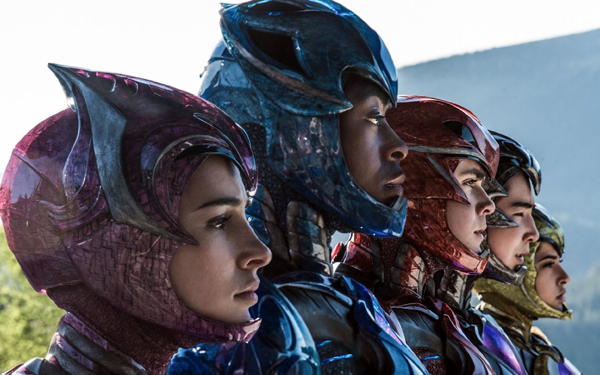If you were a kid in the mid ‘90s, there’s a good chance Mighty Morphin Power Rangers was your thing. Originally created by Haim Saban and Shuki Levy, the television series about five teenage superheroes tasked with saving their town from the evil villain Rita Repulsa was a global phenomenon.
With the last film version released 20 years ago, it was just a matter of time before the series saw another big-screen reboot. And Oscar-nominated screenwriter John Gatins (Flight, Real Steel) took on the challenge.
Creative Screenwriting spoke with Gatins about how the film appealed to him on several levels, and how he approached the task of staying true to the original material while updating it for a modern audience.
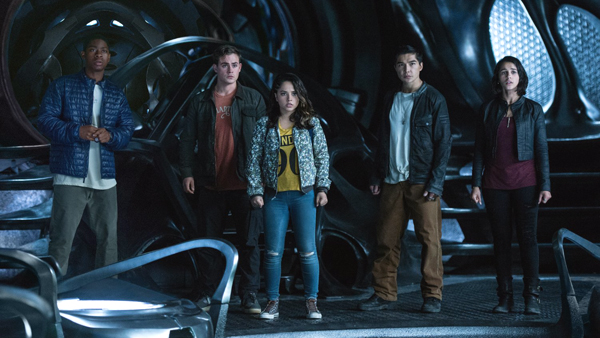
RJ Cyler as Billy, Dacre Montgomery as Jason, Becky G. as Trini, Ludi Lin as Zack and Naomi Scott as Kimberly in Power Rangers © 2016 – Lionsgate
How did you become involved with this project, and what made you want to do it?
It’s an interesting story actually. Over two years ago I had a meeting at Paramount. The guy who was running the studio said “I want to show you a movie”. So I said OK and he screened the movie for me and a friend of mine at the Paramount lot the next day.
It was called Project Almanac and was directed by Dean Israelite. I loved it. I loved the whole vibe of the movie, and the young ensemble teenage cast. I just thought “this is really cool”.
It was probably a year later that I got a phone call from Marty Bowen, one of the producers of Power Rangers and a guy that I’ve known for a really long time. He asked if I would come in and talk about the movie with them as they were working on scripts and trying to get some drafts together. He told me they had Dean Israelite as director, and I had really wanted to meet him because of Project Almanac. So I said “Yes, that sounds great, I’m very interested in that!”
So it was kind of like this funny little bit of kismet that linked us up. We all got in the room, and I loved what Dean had to say about the direction he wanted to take the movie. So I was in.
It’s been close to 25 years since the television series first premiered. With a reboot such as this, do you have a so-called “target audience”?
It’s interesting, because I’m now old enough that I have teenage kids. And besides the director, the other draw for me in terms of the movie was that it had teenage characters, which I always like in movies and enjoy writing for. So for me, it was a fun opportunity to visit what Dean and I were trying to envision as contemporary issues facing contemporary teens. I was really excited about that.
But we also obviously wanted to honor the original series and the fanbase. We had great partners in the Saban people, who were really helpful in talking to us about the mythology, and showing us certain things, and keeping us in line with all of those elements.
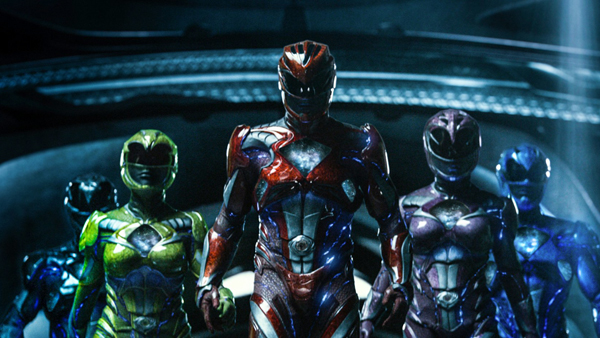
Ludi Lin as Black Ranger, Becky G. as Yellow Ranger, Dacre Montgomery as Red Ranger, Naomi Scott as Pink Ranger and RJ Cyler as Blue Ranger in Power Rangers © 2016 – Lionsgate
Did you have a fair bit of wiggle room when it came to updating it for a new audience?
We did, and it was fun because there were things that we could do. We rewrote a little bit of history, and also kind of created history that didn’t exist before, especially around the Rita Repulsa character, and Zordon and their relationship. That was really fun.
There was also the idea that we could do these five origin stories to try to show a little bit of insight into who the Rangers were before they became those Rangers. That was a great opportunity.
With some 150 episodes and other movies to work with as source material, not to mention the mythology, what was your research process like? It sounds overwhelming.
It was. I think that for the fans, they’ll recognize the original pilot of Mighty Morphin, as a springboard of sorts. I was most familiar with that series because my kids discovered it when they were really little, and I used to watch it with them. So Mighty Morphin was my baseline of knowledge.
And then we started to work with the Saban folks, who were a great resource, to answer questions and shape the story as far as the world of Power Rangers, and the characters and villains and everything else. As far as all of that stuff was concerned, Saban was great for that.
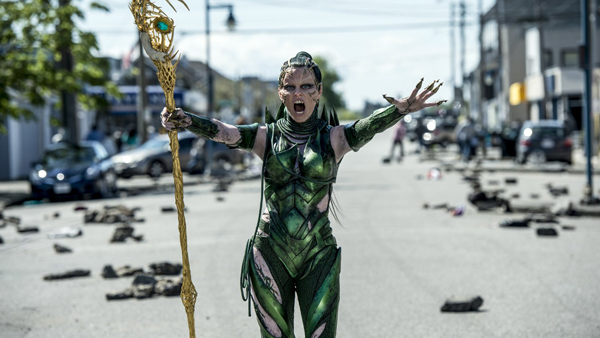
Elizabeth Banks as Rita Repulsa in Power Rangers © 2016 – Lionsgate
You mentioned that you enjoy writing teenage characters – what did you like about these five in particular and what did you want to explore?
I talk about movies that I grew up on, like John Hughes’ The Breakfast Club. If that movie were made today, what would those characters be facing as far as issues that exist in their lives? There was no internet back then! The idea of social media troubles and cyber bullying and the idea of the autism spectrum… All of these issues that come up for these kids in our film are ones we wanted to feel current.
We wanted to feel that teenagers of today could really recognize and see themselves in the movie – that was important to us.
What were some of the more challenging aspects of this project?
I would say that it was trying to maintain the balance of telling the three-dimensional personal origin stories of five superheroes as opposed to one. That was a challenge, because we could have done more and more and more for each character.
We tried to do the best we could to give as much dimension to each character as possible – and to also marry that with the world of Power Rangers as it comes to them. So to manage our “bad guy” plot and put all of those things together, maintaining pace and energy… it was a challenge.
This obviously has the potential to become a series. Being the first in the reboot, what did you want to establish story-wise?
I think I keep going back to the idea that if you’re invested personally in the characters, you’ll follow them anywhere, whether the movie is about kids with super powers or whatever. So I think that was important for us, to try to establish this ensemble in a way that was emotional and funny and entertaining, and that really reeled you in. That was a very important part of it for us.
You started off your career as an actor – what caused you to turn to screenwriting, and what made you stick with it?
It’s a funny thing because yes, I started as an actor, but when I was at Vassar College I studied dramatic literature as part of my degree. I had these great professors and we read everything, from the Greeks to David Mamet. So I was always studying dramatic form and different plays.
I think that without knowing it, even as an actor I was learning the shape of dramas and intent inside of scenes. Being an actor was a really good study for being a writer, which I didn’t really realize until I sat down to write my first screenplay. I felt natural to me, and – kind of like in The Karate Kid’s “wax on, wax off” – it was suddenly like “wait a second, I’ve read ten thousand scripts and TV pilots and plays and so on…I guess I kind of know dramatic structure without knowing that I actually studied it in some way”.
So it felt good instinctively.
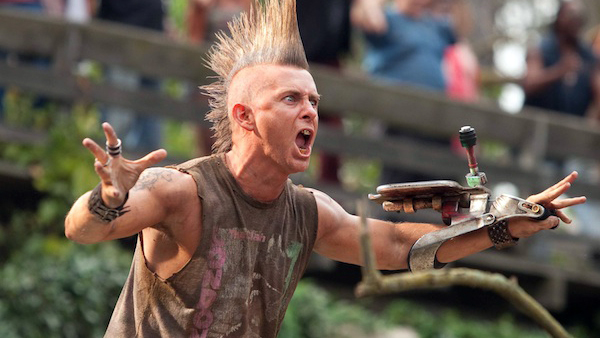
John Gatins as Kingpin in Real Steel. Photo: Melissa Moseley © DreamWorks II Distribution Co., LLC. All Rights Reserved
Finally, do you have any advice you could offer our readers?
Write! I think it’s just one of those things, because I still have to tell myself that all the time. As we all know as writers, that blinking cursor on a blank page is a very daunting thing.
And doubt is such a crusher – it can be so debilitating to feel “I don’t know that this is a good idea” or “no one will care about this”. It’s very hard to stay focused and confident and motivated.
So do anything that can inspire you, whether it’s listening to good music or exercising or doing stuff that shakes your brain a little bit…walking around a museum.
I like airports. I like to get to the airport early and sit there and watch the world and think.
I have random conversations with people – I always find myself talking to folks working at Starbucks or wherever. Interacting with the world inspires you.
I also think that with these cellphones we have in our pockets, there’s no excuse not to make a movie. My kids are always showing me stuff on YouTube and different sites where people are doing amazing things. I think there are great opportunities to generate content that’s really creative and can become more longform, like a movie script.
